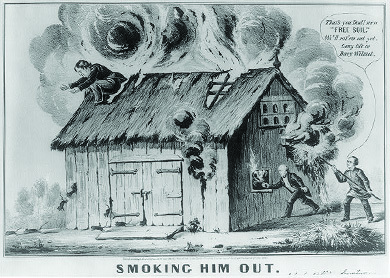| << Chapter < Page | Chapter >> Page > |

In the wake of the Mexican War, antislavery sentiment entered mainstream American politics when the new Free-Soil party promptly selected Martin Van Buren as its presidential candidate. For the first time, a national political party committed itself to the goal of stopping the expansion of slavery. The Democrats chose Lewis Cass, and the Whigs nominated General Zachary Taylor, as Polk had assumed they would. On Election Day, Democrats split their votes between Van Buren and Cass. With the strength of the Democratic vote diluted, Taylor won. His popularity with the American people served him well, and his status as a slaveholder helped him win the South.
Visit the archives of the Gilder Lehrman Institute to read an August 1848 letter from Gerrit Smith, a staunch abolitionist, regarding the Free-Soil candidate, Martin Van Buren. Smith played a major role in the Liberty Party and was their presidential candidate in 1848.
The election of 1848 did nothing to quell the controversy over whether slavery would advance into the Mexican Cession. Some slaveholders, like President Taylor, considered the question a moot point because the lands acquired from Mexico were far too dry for growing cotton and therefore, they thought, no slaveholder would want to move there. Other southerners, however, argued that the question was not whether slaveholders would want to move to the lands of the Mexican Cession, but whether they could and still retain control of their slave property. Denying them the right to freely relocate with their lawful property was, they maintained, unfair and unconstitutional. Northerners argued, just as fervidly, that because Mexico had abolished slavery, no slaves currently lived in the Mexican Cession, and to introduce slavery there would extend it to a new territory, thus furthering the institution and giving the Slave Power more control over the United States. The strong current of antislavery sentiment—that is, the desire to protect white labor—only increased the opposition to the expansion of slavery into the West.
Most northerners, except members of the Free-Soil Party, favored popular sovereignty for California and the New Mexico territory. Many southerners opposed this position, however, for they feared residents of these regions might choose to outlaw slavery. Some southern politicians spoke ominously of secession from the United States. Free-Soilers rejected popular sovereignty and demanded that slavery be permanently excluded from the territories.
Beginning in January 1850, Congress worked for eight months on a compromise that might quiet the growing sectional conflict. Led by the aged Henry Clay, members finally agreed to the following:
1. California, which was ready to enter the Union, was admitted as a free state in accordance with its state constitution.
2. Popular sovereignty was to determine the status of slavery in New Mexico and Utah, even though Utah and part of New Mexico were north of the Missouri Compromise line.
3. The slave trade was banned in the nation’s capital. Slavery, however, was allowed to remain.
4. Under a new fugitive slave law, those who helped runaway slaves or refused to assist in their return would be fined and possibly imprisoned.
5. The border between Texas and New Mexico was established.
The Compromise of 1850 brought temporary relief. It resolved the issue of slavery in the territories for the moment and prevented secession. The peace would not last, however. Instead of relieving tensions between North and South, it had actually made them worse.
The acquisition of lands from Mexico in 1848 reawakened debates regarding slavery. The suggestion that slavery be barred from the Mexican Cession caused rancorous debate between North and South and split the Democratic Party when many northern members left to create the Free-Soil Party. Although the Compromise of 1850 resolved the question of whether slavery would be allowed in the new territories, the solution pleased no one. The peace brought by the compromise was short-lived, and the debate over slavery continued.

Notification Switch
Would you like to follow the 'U.s. history' conversation and receive update notifications?